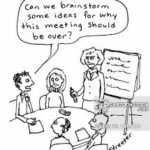How To Make More Money. Or, The Most Valuable Lessons I learned While Running Internet Startups and Advertising Agencies
 Ah, make more money. A quick story. I was once in a cooking class in Chang Mai Thailand. One of the very funny chefs told us that she could charge more for her stir fries if she cut the carrots into star shapes. This was a very smart strategic decision to easily add a little bit of chutzpah to a dish that could be had all over town. A simple addition that, in the end… “made more money.”
Ah, make more money. A quick story. I was once in a cooking class in Chang Mai Thailand. One of the very funny chefs told us that she could charge more for her stir fries if she cut the carrots into star shapes. This was a very smart strategic decision to easily add a little bit of chutzpah to a dish that could be had all over town. A simple addition that, in the end… “made more money.”
Allow me to state the obvious… Not all businesses are created equal and not all bother to make star shapes. Some have valuable products and services; some are run by charismatic leaders; some are uber creative in their approach; some have a fabulous culture; some are strategic; and some are local, even neighborhood, market leaders.
Regardless of each company’s strengths, to survive in a world of thousands of companies (i.e. consumer options), they all need to be:
Well-Managed.
These insights and strong personal opinions on how to run a profitable business come from my thirty years in global and local advertising agency management and ownership and CEO and founder of two internet companies.
 I spent my first sixteen years in advertising as a senior account director, general manager and business development director at Dancer Fitzgerald Sample (New York’s largest ad agency) and in New York and London at Saatchi & Saatchi Advertising Worldwide (the world’s largest agency.) I must have been into large.
I spent my first sixteen years in advertising as a senior account director, general manager and business development director at Dancer Fitzgerald Sample (New York’s largest ad agency) and in New York and London at Saatchi & Saatchi Advertising Worldwide (the world’s largest agency.) I must have been into large.
In left advertising in 1995 for seven years to be founder and CEO of two Internet publishing and technology startups. To put it mildly, it was great fun to learn how to build websites, invent ad units, grow large traffic and to monetize the first set of Internet advertising programs. Microsoft bought our natural language processing company ActiveBuddy (then called, I’m sorry to say, Colloquis). Millions of people knew Activebuddy for our snarky and smart SmaterChild chatbot.
After my digital sojourn, I moved to Oregon in 2002 to buy a regional advertising agency. In the ten years that I ran the agency, we bought the sports marketing agency Citrus; rebranded and repositioned the company; expanded to two offices and added national clients like Dr. Martens, Harrah’s, Legalzoom, Nike and the U.N.
The following is what I learned during my tenure as a businessman, global account director, big agency business development director, buyer and seller of three agencies and, most importantly, as a small agency owner.
Have A Marketing Plan.
Many (most?) companies do not have an active / current marketing plan. In fact, most don’t have a business plan. Yikes! Having both of these will put you way ahead of your rivals.
My Oregon agency’s business plan helped us grow our account list and increased the agency’s valuation through acquisition; the opening of a second office; the development of an efficient and very creative new business program and the addition of Nike AOR business (which helped us gain even more desirable clients like Dr. Martens, Montana Lottery, and Legalzoom).
Note to the 45+ crowd. The plan also acted as a framework to begin to position the company for an eventual sale.
Be Different.
Create a brand and / or product positioning that differentiates your company from your competition. Right on, you’ve heard this one many times. Good. This just might be the most important thing you can do for your brand and people.
The drill here is to have a distinctive and memorable brand positioning – it’s really a sales proposition — that actively attracts and stimulates interest from the right new clients and customers. This is the important part: Just trying to find yet another new way to say “digital” or “full- service” agency or pizza parlor, just might not be good enough – and its really difficult to find a new way to say the same old, and generally non-competitive thing. Instead, it might be time to think through some business models and products 9or, how you describe your product) that will more effectively get you to that truly distinctive and compelling sales proposition.
Watch Your Costs.
You are a business first. Control all costs. Cost control just might be the only thing you can totally control.
This sounds obvious, but it is critical in an increasingly low-margin service business like advertising. My metric was that every dollar I paid to someone else was a dollar I couldn’t hand to my kids, staff or pay off the 1992 Porsche 911.
Stare At Your Numbers.
We advertising people are visual so my Citrus Agency CFO created financial dashboards as a graphical management tool. We had detailed monthly financial dashboards tied to our P&L, balance sheet, accounts receivables and owner compensation (this one tended to focus our business decisions.)
We also used a real-time SWOT (Strengths, Weaknesses, Opportunities, Threats) assessment for all major company decisions like mergers and acquisitions, go-no on RFPʼs and to help manage and assess existing accounts and staff.
Only The Best.
 Hire only exceptional people – that’s what Google does, so why not you? Do not rush to fill a position. You will often pay for your speed to hire in the long run.
Hire only exceptional people – that’s what Google does, so why not you? Do not rush to fill a position. You will often pay for your speed to hire in the long run.
I realize that we are now in a relatively tight labor market. Finding the best, most experienced people is getting more difficult. Here is one of my hiring mantras…
I can train a very smart person. But, I can’t train a person to be smart.
Cut It Out.
Miscast or problem employees should be dealt with earlier than later. Don’t let bad situations fester. Everyone, in many cases even the one to be cut, wins.
Team, Please.
Your employees need to know what is going on at your company, with your clients and customers, your suppliers, and in the marketplace. Employees need to have a sense that leadership is on the ball and that they, the employees themselves, might be able to help grow the company. Therefore, make sure to keep all employees in the loop via scheduled meetings and updates. It takes more than a foosball table to build a business-building culture. C.E.Os. need to talk it up. Even some obvious cheerleading works. As a manager, I subscribed to Tom Peterʼs management concept of MBWA. Look it up.
Reward The Best First.
Reward your best employees first. Group raises are not constructive. Does this sound harsh? There is no question that an exceptional employee partner is as valuable as two marginal people. This approach beats not having investment capital for other needs or having to go out of business because you were sooooo magnanimous.
25% Is Scary.
If you are a service business, be concerned if any single client accounts for more than 25% of your revenues. When we added two Nike Agency Of Record assignments, I was elated but got nervous about how much of our revenues Nike accounted for. As a result, rather than coasting on a new business win, we dialed up our new business programs to add other accounts.
Just Say No!
Learn how to say no to clients and prospects that want too much free brainpower. Your brains, ideas, and pixels are all you have to sell. Charge like a lawyer or even SEO specialists that charge hourly rates just like lawyers. It is time for the advertising industry in particular to exhibit some self-control.
It is OK to occasionally give things away. That’s how we keep friendly clients and hopefully have them think of us as ‘partners’. But, if you have to give too much away for free, it might be time to examine the value of what you are selling and the mindset of your client or prospect.
Just Say No, Redux.
Every advertising agency search consultant I know has told me that advertising agencies pitch too often. Their expert advice? Learn how to say – NO!
I have a handy Go / No-Go pitch decision-making tool on my blog. Just search on ‘Pitch Playbook’. or, buy my book — it is at the top of this post.
Productize.
If you are a service business, think about an alternative to the notion that brainpower and creativity are all you have to sell. Take some of that brainpower to find out how to create a product or service for your own business that can easily be replicated and sold over and over. Take a look at what Salesforce does.
Think like a “start-up.” I know, I know… “Let’s build some IP” can sound like a too obvious panacea. However, there is gold in them thar hills. For example, there are advertising agencies teaming up with brewers to create new craft beer brands; agencies moving into research and agencies like Wieden+Kennedy that are becoming start-up incubators. I asked W+K why they are doing this. The answer… they are investing their brains and experience to make more money in a world that Mad Men couldn’t have conceived.
Need seed money for a new venture? Try crowd funding. Think big like the kid down the street. I bet your team could build one of the more effective Kickstarter sites to fund your own thing.
It Is Digital Stupid.
Grow your digital assets faster. Bring on more technologists (developers and strategists) to leapfrog even early-adopter digital agencies or businesses that “get it”. Pick a growth area.
One more digital point, and I know that you know this — digital agencies have a higher multiple than full-service agencies. Digital agencies get bought. This goes for virtually any smart business.
It Is About Service, Stupid.
Provide exceptional service. All client facing employees must know (or be trained to know) how to think like a customer or client in order to anticipate client needs and address any potential issues before they materialize and metastasize.
The worst type of call I ever got was a client telling me that the agency’s account service sucked. Consider sending your AEʼs to an AE class. It’s just so easy to fix. Fixing creativity is much harder.
One more point. Very happy customers will refer your company to their friends. Pissed off customers will write something like what I wrote about Bank of America.
Work Process Please.
Create a work process that is dedicated to profitability. No, this is not SOP.
Manage Meetings.
 Meeting management is critical to your company’s mental and financial health. (!)
Meeting management is critical to your company’s mental and financial health. (!)
Do the math — lengthy over-staffed meetings can easily cost thousands of staff-related dollars a year. Find a meeting management system that will work within your culture. Keep attendee numbers small, there is no reason to fill up the room; clearly state the meeting’s objectives; select a meeting leader; don’t hold up the meeting for stragglers (it is disrespectful and we are all busy) and schedule a hard- stop end time to get up and get back to the real work.
Stay Very Hungry.
I guarantee that some of your customers will eventually walk out the back door. That’s why you need them to come in the front door faster. Waiting to dial up sales is crazy. Business development is a 24/7 priority that needs a solid plan, an active approach and constant senior management attention.
Did I say 24/7? The majority of businesses don’t even have a master marketing plan.
By the way, that’s Arnold at the left.
The Business Development Plan.
My perspective on how to build and run a business development program for your company won’t fit on this page. Visit my 500 plus blog posts for a deeper dive.
However, based on my international mega-agency, client-side and small agency owner experiences… consider the following questions.
- Do you have clear business objectives?
- Are you positioned for distinction and to win the clients you want?
- Do you know what business categories and clients you should be targeting and why? I built a decision matrix to help the agency focus.
- Do you fully understand a potential client’s pain points and potential objections to your pitch?
- Are you willing to do the work to make your agency famous?
- Have you developed an annual inbound and outbound marketing program that runs 24/7?
- Do you have an easy to use, and gets used, CRM system?
Pitching & Presenting.
Individual product and service pitches cost thousands in labor and out of pocket costs. If there is anything that your company must do is to have a well-organized and strategic new business pitch system.
I wrote The Levitan Pitch. Buy This Book. Win More Pitches. a book on how to create and manage new business pitches just for you. I wrote it to be clear, direct and a how-to book on how to win new accounts.
You can buy the book on Amazon — it is at the top of this page. While it is aimed at ad agencies, everything I discuss will work for any business category.
Think Niche.
I’ve helped a couple of businesses go niche this year. Especially ad agencies.
Even if you are a full-service agency, consider leading your new business program with a high-interest niche service or product.
As an example, my agency used and very innovative “invisible QR codes” program (that happened to be developed by our client Digimarc) to get us into companies like Nestle and P&G. We would have never gotten that first meeting with that Fortune 500 if we simply said that we were yet another full-service shop. FYI: you’ll dig this blog post on how Nike made me want to sell my ad agency.
You can go niche via the creation of a specialized niche industry website. Some days it seems to me that every small to medium sized agency I talk to wants to specialize in ‘healthcare’ marketing. I get it. There is money out there. So, why not build a smart, industry-leading and highly targeted niche healthcare marketing website that will help you stand out and look like a true expert.
The Me-Too Website.
Bad = A website that looks and sounds like all of your competition’s websites.
Worse = A website plan that does not recognize that the website’s main objective is to sell. You may only have 20 7 seconds to entice a prospect to dig deeper. Having a me-too website that doesn’t sell is a critical missed opportunity.
In particular, I’ve reviewed hundreds of advertising agency websites (I’ve also built over 50 mega websites) and have very strong opinions about what works and what doesn’t.
Frankly, I couldn’t deliver my POV any better than Mark O’Brien at Print.com:
“Many designers believe that their siteʼs central function is to show their visitors how creative they are. I disagree. Certainly, a portion of the site should serve this purpose, but this is not the primary purpose of the site. The siteʼs key role is to generate business, and demonstrating creativity is only part of what converts a visitor into a prospect.”
Chemistry.
Prospective clients consciously and unconsciously look to interpersonal chemistry when they make a business selection decision.
It is therefore that you mange how you build chemistry. This should not be left to chance. First of all, use your website to get personal and tell your story (why not introduce your business with a personal 1-minute video – I can point you to a few examples). Next, make sure that all elements of your business development program are designed to build chemistry. And, finally, read my book’s interviews with 20 leading advertising agency leaders and client search consultants on the importance of chemistry to your bottom line. It is amazing how many think chemistry is the final / ultimate decision-making criteria.
Steve Jobs created for chemistry iPhones, right?
Thought Lead.
Become known as a relevant and valuable thought-leader. Strategic, as in well-targeted, thought-leadership will position your company as being smarter than the next guy, drives brand awareness, delivers targeted traffic to your website and can be extended to email programs, across social media (from SlideShare to Pinterest), presentations, webcasts and speaking engagements. Super smart thought leadership gets shared.
My agency Citrus had a monthly thought-leadership publishing schedule and staff assignments – it worked. But, don’t go social unless you know that your company can realistically sustain the program. Empty Twitter feeds don’t breed confidence.
Need A New Model?
Consider dumping your current business model if it doesn’t look like the category leader of the future. Things are moving way to fast for you to stand still. Explore the benefits of employing a leaner and meaner approach.
Act with a need for speed. Before my partner and I decided to sell Citrus, I thought about renaming Citrus “Portland” (why not own our uber creative city?). We would also move to a small core senior team and shift the other employees to freelance contractors managed by a symbiotic community system. Keeping your freelancers as best friends is a major win-win.
The goal was to create a highly intelligent, nimble and lower-cost ecosystem that would be managed on a client-need basis. Too put it another way, we wanted to have a less FTE dependent approach in a world of increasing project-oriented jobs. I shoulda, coulda, woulda… but didn’t.
Smart Partners.
Have smart business partners who share your vision and are smarter than you. Strive to not be the smartest guy in the room.
One more thought…
 What would I do if I started it all over? As in a new advertising agency… (note, new wors for any business)…
What would I do if I started it all over? As in a new advertising agency… (note, new wors for any business)…
I’d use strategic scenario planning and an honest SWOT analysis to plan an agency that’s built for the future – say three years out. I’d even do a bunch of research with client-types to help find out what they are really looking for in an agency. Oh, and how they search for agencies. Guesswork can be expensive.
I am very sure that my new agency wouldn’t look like my old one.
It would certainly have more digital chops (more digital strategists and developers like I had at my Internet companies) and the agency would run leaner. If you can’t do a complete overhaul (and I wouldn’t drag my feet too long), then at least begin to make real market-based modifications to meet the accelerating changes happening in the business of advertising, design and technology.
Frankly, this need for new thinking applies to all agencies. Even the digital agencies that look good today could quickly be displaced and some are. I am sure there are brand new uber-technology-driven agency models being formulated in someone’s backroom as I write.
Ok, One More
Don’t forget to …. Ask for the order.
I know that’s a lot to chew on. I can help you digest these thoughts and action items. Hey, let’s talk and get going – today. Take me up on my impossible to refuse Corleone offer to talk for 15 stimulating minutes.
Thanks for reading. Let me know if you have any questions. My email address is peter@peterlevitan.com.

Leave a Reply